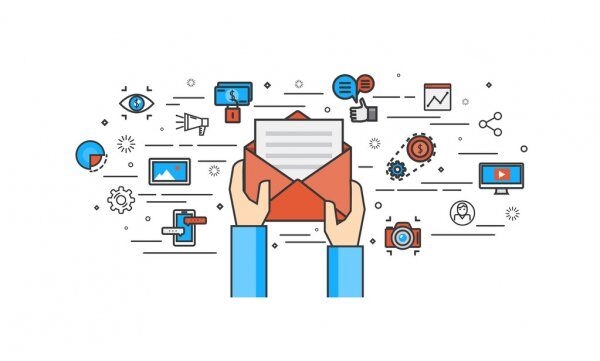
Image credit: Depositphotos.com
The desire for a highly personalized online shopping experience isn’t rocket science — it’s just basic instincts. There’s no shortfall of statistics proving the vital importance of personalization. The knock-on effects of thick and fast technological advancements have induced a rapid sophistication of consumers’ taste buds. Now more than ever, consumers want to be met exactly at the point of their needs at the right moment.
The synergy between eCommerce and AI – two bludgeoning technologies with phenomenal potentials – is promising unlimited potentials for eCommerce personalization. This synergy will change the general mode of online shopping and propel eCommerce to a multi-trillion dollar industry.
I’m not just going to drone on about the use of chatbots and personal assistants in ecommerce sites. AI-powered applications are proliferating at an incredible rate, with industry powerhouses like Google and Microsoft injecting jaw-yanking funds into new AI initiatives.
Besides chatbots, there are wads of AI-powered personalization tools that can enable you to give all your eCommerce customers a highly humanized experience with minimal human intervention.
I’ve sifted through a wide array of tools and the results I’ve gathered will help address questions like “how can I use AI-personalization tools to reduce human time and cost without hurting my site’s conversion rate?”, “How can I use AI personalization tools to improve my eCommerce marketing campaigns” and “How do I know this is the right time to invest in eCommerce personalization?”
First, let’s me bring you up to speed about why now’s the best time to look into AI personalization tools for eCommerce.
Why Now’s the Best Time to Invest in AI Personalization Tools for eCommerce

Image credit: Depositphotos.com
The Lower Cost of Computing:
With the cost of computing declining year-on-year and cloud computing becoming ubiquitous, AI personalization tools have increasingly become cheaper and more affordable. AI-enabling hardware such as NVIDIA GPUs, which power deep learning applications and the processing of intricate neural queries, are now basic features of computing devices including tablets, desktops and servers.
Advancements in Human-Like Technologies:
Coupled with advancements in Machine Learning (ML), the huge strides made in neural networks and deep learning have edged us much closer towards the perfection of human-like technologies. In some areas like computer vision, technology has surpassed human capabilities.
The Ubiquity of Internet-Enabled Devices:
The proliferation of mobile and IoT devices has fuelled the rapid expansion of the eCommerce industry. Leading eCommerce companies are doubling down on the trend to drive more sales using A.I. They’re using the wealth of data generated from these devices to elicit actions and insights through A.I-powered applications. A.I systems feed off data; the wider their exposure to human inputs, the more efficient they become.
The Greater Ease of Evaluating Proof of Concept:
Some years back, it was only possible to implement and improve eCommerce systems through A/B testing. This was time-consuming and costly because you needed to try out only two alternate versions of a concept per testing round to find out what works best before moving to another A/B test to find an improvement.
But thanks to advancements in A.I technology, retailers can explore a treasure trove of data points such as location, age, preferences, shopping history, etc to optimize their eCommerce sites quickly.
10 Ways to Deploy AI-Powered Tools to Personalize your eCommerce Experience
Customized Search Results

Image credit: Depositphotos.com
Irrelevant and mismatching search results are major contributing factors of customer turnovers on eCommerce sites. But with A.I tools for personalizing search results, you can help your customers find the exact products they need promptly.
An A.I-powered search algorithm can analyze customers’ search history to deduce patterns such as color, materials, size, or brand. An eCommerce search engine can also be imbued with nifty visual capabilities for exploring visual cues.
Picture this: Someone finds a senior official wearing a high-tech smartwatch with intriguing functionalities during a team meeting. Too shy to walk up to the official to ask about the smartwatch, he manages to take a few closeup shots of the watch as they work together.
He uploads the photos on an eCommerce site, and voila! He’s one click away from ordering the product with all the information he needs falling on his laps!
The customer doesn’t need to scour through an endless list of products to find the exact product. Even if the result shows closely matching products, it’d still help the user save some time.
Such customizable search results are all the more expedient in fashion eCommerce stores, where written search requests are hardly as revealing as visual cues.
Dynamic Pricing and Perks

Image credit: Depositphotos.com
Dynamic pricing is a long-standing pricing model that can ramp up your eCommerce store’s conversion rates. You can use A.I applications to offer different prices of the same product to different customers depending on unique personal factors.
Advanced applications can take many other factors into account like the prices charged by competitors who the buyers have patronized before, the current demand for the product, cross-price elasticity, halo relationships, etc. Some A.I powered dynamic pricing models can also deploy deep learning capabilities to deduce prices that each customer will be willing to pay for a product or service at a particular time.
Granify is an excellent example of these concepts at work. The app analyzes 100’s of buyer data points to offer personalized pricing and incentives. The app’s machine learning capabilities allow it to detect hesitations and show teasing messages like free shipping or free trials to convert indecisive customers.
You’ll also find a perfect demonstration of personalized pricing with Personali, an Intelligent Incentives platform. With a machine learning algorithm developed by data scientists and behavioral economists, the app converts window shoppers to buyers by offering optimized incentives based on data from the user’s real-time experiences.
Retargeting Visitors

Image credit: Depositphotos.com
Customer retargeting is undoubtedly one of the greatest ad strategies of modern times. A.I can take retargeting to another level by harnessing a massive pool of consumer data to increase the level of personalization of each successive ad.
Machine learning algorithms can explore numerous data points of a tracked potential customer, learning more and more about the target’s behaviour to craft messages they’ll likely respond to.
Advanced A.I retargeting tools integrate visual recognition algorithms that monitor a customer’s dwell times on physical and virtual stores. The tool categorizes products a customer may be interested in based on the amount of time a customer spends on them.
The next time the user sees an ad or promo from the store, it’ll be about the products that they’ve taken a liking after. An A.I retargeting algorithm can even monitor a target’s dwell times in other places online to learn more about the customer.
A.I-Based Email Marketing

Image credit: Depositphotos.com
The most important determinant of email conversion rates is the perceived relevance of the mail contents. Customers may put off reading an email that looks interesting but has nothing to do with their pressing needs, or they may ignore all irrelevant mails altogether.
A.I can help supercharge your email marketing by making it more relevant to the recipients. A.I can help further humanize your email campaigns. Such personalized emails are more likely to resonate with the recipients than cold, automated ones.
With A.I-powered customer analyses, you can amp up your emails’ open rates by sending offers that customers are truly interested in at the time when they’re most likely to read about them.
The dynamic email campaign can also take advantage of actions that customers take in real-time. For instance, if they click on a certain link and perform a certain action sequence after opening the mail, they get a streamlined followed up email sequence.
Big data can also make a huge impact on your email sequences with A.I-powered integrations. A.I-powered analysis of a customer’s public records, including social media posts, public webpages, etc, can provide insights to help fine tune your email marketing campaigns.
Personalized Buyer Journey

Image credit: Depositphotos.com
A.I tools can help you streamline your buyers’ journey to save them time and other valuable resources. With A.I, you can free your potential buyers from everything they’re not interested in and present them only with what resolves their pressing needs every time you have their attention.
With A.I-powered algorithms, you can easily elicit customers’ inputs to learn more about them by making it easier for them to drop their inputs. Machine learning and natural language processing systems such as Siri and Alexa process voice requests to identify and solve customers’ problems.
Some A.I personalization tools can even initiate conversations that draw inputs from customers. For instance, a chatbot on a supplement online store can ask a customer questions like ‘have you met your recommended daily intake of calcium today’ or ‘when last did you check your weight’, depending on analyses of the customer’s behavior.
The customer’s responses can then be used to figure out the best product recommendations for them.
A.I can also serve as the magic wand that breathes life into your website’s U.X. You can use machine intelligence to optimize the contents, features, and layout of your website to maximize its dwell times and conversion rates.
Personalized Recommendations

Image credit: Depositphotos.com
The phenomenal data-crunching capabilities of A.I can deduce valuable insights from boatloads of customer data to offer highly relevant recommendations. In fact, product recommendations is one of the areas of eCommerce where A.I will have the greatest impact.
Big-money industry players are keener on exploring A.I for product recommendations than for many other purposes. The possibilities are also open to small businesses, especially given the ease with which customer-generated inputs can be elicited today.
A.I personalization tools for product recommendations harness a wide range of data sets, including those of contact details, purchase history, contextual information, and public records.
A.I powered product recommendations can also help make up for any shortfall of the human touch in the online shopping experience.
Your customers may not find a chatty attendant who’s eager to lend them an ear and offer product recommendations, but A.I algorithms can use big data to work the magic and offer suggestions that are right up their alley. Also the more the A.I system gets exposure to a customer’s data, the more likely it is to eke out contents that resonate.
AI Wallets and Payment Processors

Image credit: Depositphotos.com
Another critical factor of abandoned carts and churn rates – one which eCommerce site owners tend to ignore – is the hitches in payment systems. With A.I payment processing tools, you can speed up checkouts, beef up security, and enhance the overall user experience of your eCommerce site.
You can take your A.I payment integrations up a notch with more advanced features that analyze and adapt to customers buying behaviors. For instance, Clarity’s A.I-powered payment solution tracks and analyzes the spending habits of customers to find ways to help them save up on recurrent expenses.
The algorithm recommends credit cards with lower fees as well as other tips to save money. The more the software learns about a user, the more accurate and effective are its recommendations.
Another advanced A.I integration for payment system deals with false declines. Sometimes, a glitch or a suspicious action sequence might falsely trigger a decline from the underlining transaction protection mechanisms of the site.
This is a common experience among eCommerce customers, and it takes a highly advanced threat detection mechanism to nib it in the bud. Researchers believe it’s a $ 118 billion problem in the U.S alone. Companies who’re able to deploy A.I solutions to these problems gain a crucial competitive edge.
Personalization Across Device Ecosystems

Image credit: Depositphotos.com
These days, with the proliferation of wearables and IoT devices, you leave a massive treasure trove of customer data on the table if you focus only on information from a single touchpoint like a smartphone or a PC. With A.I tools, you can deploy a multi-channel approach to eCommerce personalization.
With a multi-channel approach, you have a clearer picture of your customers’ digital activities. This universal approach helps you create a well-rounded, customized experience for your customers on each device across their device ecosystem.
The data points can be elicited using device-specific methods, for instance, websites for PC, mobile apps for smartphones, social media campaigns for smartwatches, etc.
For example, if your potential leads chat at length about a vacation on their iPhones, they’re greeted with recommendations for camping and hiking gears the next time they visit your eCommerce site on their desktop.
Such a universal user experience will undoubtedly make life easier for your eCommerce customers.
Localized Customer Experience

Image credit: Depositphotos.com
Another way of using A.I personalization tools to make life easier for your eCommerce customers is by localizing their experience.
A.I localization tools are catching on faster in the travel sector.
However, the technology can spare frequent travelers as well as locals from several hiccups and mix-ups on an eCommerce site. The technology’s key value proposition is the integration of geographical parameters to enhance the relevance of recommendations and search results.
The technology addresses the geographical circumstances of the user, filtering out solutions that would otherwise be suitable. For instance, a CBD online shop’s search engine can automatically filter results based on the THC limits on cannabis products applicable to the buyers’ jurisdictions.
Only products with less than 0.3% of THC contents show up for buyers in the U.S, while New Zealand residents see only products with 0.2% THC.
In other cases, customers’ online activities can be analyzed to draw conclusions on how best they can be served in their current locality. For instance, a clothing online store can offer users planning business trips a set of recommendations different than those given to others planning a family vacation in the same location.
A.I for User Privacy

Image credit: Depositphotos.com
Finally, you can use A.I personalization tools to assuage your customer’s concerns about their security and privacy. Using A.I tools to enhance user’s privacy is a balancing act given the humongous amount of personal data that you’ll have to dig up when using the other types of A.I tools.
It’s even more imperative to consider safeguarding your customer’s privacy given people’s increasing awareness of their digital fingerprints following the series of privacy scandals that have rocked technology powerhouses in recent times.
The good news is that you hardly need any additional set of tools besides those mentioned above to implement this strategy. The entire strategy actually revolves around getting your customers to agree to disclose some personal information in exchange for the benefits of a highly personalized user experience.
For instance, Google Now requires access to users’ accounts, and in return, it syncs users’ calendars, email, and browsing habits to expedite their daily decision-making processes. Most users will be pleased to trade their information for such time-saving personalized experience.
Woo your Customers with Unparalleled Personalized Experiences!
Don’t just aim to provide customers with great value for their money, provide more value for their time also! You’re less likely to elicit a positive response if you present viewers with the best deals at the wrong time. A.I Personalization tools help you give your customers exactly what they need when they need it the most.
You’ll be amazed by the increase in your site’s conversion rates when you begin to explore A.I personalization tools.
Digital & Social Articles on Business 2 Community
(74)
Report Post






